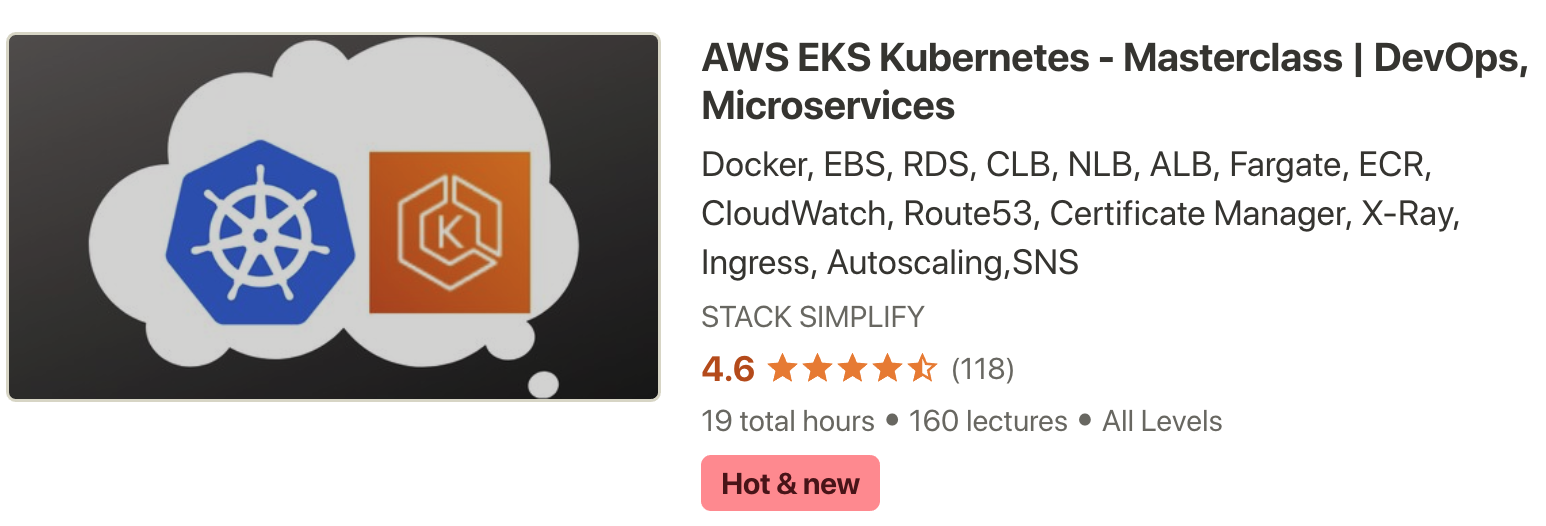Kubernetes Architecture ¶
Step-01: Why Kubernetes? ¶
- We need to understand why Kubernetes to be used
Step-02: Kubernetes Architecture ¶
- We need to understand the Kubernetes Architecture in detail
- In addition to that we also need to understand how AWS takes the lead from EKS perspective
- How AWS has simplified kubernetes for us?
- With AWS EKS, what all things offloaded from us?
Kubernetes - PODs ¶
Step-01: PODs Introduction ¶
- What is a POD ?
- What is a Multi-Container POD?
Step-02: PODs Demo ¶
Get Worker Nodes Status ¶
- Verify if kubernetes worker nodes are ready.
# Get Worker Node Status kubectl get nodes # Get Worker Node Status with wide option kubectl get nodes -o wide
Create a Pod ¶
- Create a Pod
# Template kubectl run <desired-pod-name> --image <Container-Image> --generator=run-pod/v1 # Replace Pod Name, Container Image kubectl run my-first-pod --image stacksimplify/kubenginx:1.0.0 --generator=run-pod/v1 - Important Note: Without --generator=run-pod/v1 it will create a pod with a deployment which is another core kubernetes concept which we will learn in next few minutes.
- Important Note:
- With Kubernetes 1.18 version, there is lot clean-up to kubectl run command.
- The below will suffice to create a Pod as a pod without creating deployment. We dont need to add --generator=run-pod/v1
kubectl run my-first-pod --image stacksimplify/kubenginx:1.0.0
List Pods ¶
- Get the list of pods
# List Pods kubectl get pods # Alias name for pods is po kubectl get po
List Pods with wide option ¶
- List pods with wide option which also provide Node information on which Pod is running
kubectl get pods -o wide
AWS EKS - Elastic Kubernetes Service - Masterclass ¶
What happened in the backgroup when above command is run? ¶
- Kubernetes created a pod
- Pulled the docker image from docker hub
- Created the container in the pod
- Started the container present in the pod
Describe Pod ¶
- Describe the POD, primarily required during troubleshooting.
- Events shown will be of a great help during troubleshooting.
# To get list of pod names kubectl get pods # Describe the Pod kubectl describe pod <Pod-Name> kubectl describe pod my-first-pod
Access Application ¶
- Currently we can access this application only inside worker nodes.
- To access it externally, we need to create a NodePort Service.
- Services is one very very important concept in Kubernetes.
Delete Pod ¶
# To get list of pod names
kubectl get pods
# Delete Pod
kubectl delete pod <Pod-Name>
kubectl delete pod my-first-pod
Step-03: NodePort Service Introduction ¶
- What are Services in k8s?
- What is a NodePort Service?
- How it works?
Step-04: Demo - Expose Pod with a Service ¶
- Expose pod with a service (NodePort Service) to access the application externally (from internet)
- Ports
- port: Port on which node port service listens in Kubernetes cluster internally
- targetPort: We define container port here on which our application is running.
- NodePort: Worker Node port on which we can access our application.
# Create a Pod kubectl run <desired-pod-name> --image <Container-Image> --generator=run-pod/v1 kubectl run my-first-pod --image stacksimplify/kubenginx:1.0.0 --generator=run-pod/v1 # Expose Pod as a Service kubectl expose pod <Pod-Name> --type=NodePort --port=80 --name=<Service-Name> kubectl expose pod my-first-pod --type=NodePort --port=80 --name=my-first-service # Get Service Info kubectl get service kubectl get svc # Get Public IP of Worker Nodes kubectl get nodes -o wide -
Access the Application using Public IP
http://<node1-public-ip>:<Node-Port> -
Important Note about: target-port
- If target-port is not defined, by default and for convenience, the targetPort is set to the same value as the port field.
# Below command will fail when accessing the application, as service port (81) and container port (80) are different
kubectl expose pod my-first-pod --type=NodePort --port=81 --name=my-first-service2
# Expose Pod as a Service with Container Port (--taret-port)
kubectl expose pod my-first-pod --type=NodePort --port=81 --target-port=80 --name=my-first-service3
# Get Service Info
kubectl get service
kubectl get svc
# Get Public IP of Worker Nodes
kubectl get nodes -o wide
http://<node1-public-ip>:<Node-Port>
Step-05: Interact with a Pod ¶
Verify Pod Logs ¶
# Get Pod Name
kubectl get po
# Dump Pod logs
kubectl logs <pod-name>
kubectl logs my-first-pod
# Stream pod logs with -f option and access application to see logs
kubectl logs <pod-name>
kubectl logs -f my-first-pod
Connect to Container in a POD ¶
-
Connect to a Container in POD and execute commands
# Connect to Nginx Container in a POD kubectl exec -it <pod-name> -- /bin/bash kubectl exec -it my-first-pod -- /bin/bash # Execute some commands in Nginx container ls cd /usr/share/nginx/html cat index.html exit -
Running individual commands in a Container
kubectl exec -it <pod-name> env # Sample Commands kubectl exec -it my-first-pod env kubectl exec -it my-first-pod ls kubectl exec -it my-first-pod cat /usr/share/nginx/html/index.html
Step-06: Get YAML Output of Pod & Service ¶
Get YAML Output ¶
# Get pod definition YAML output
kubectl get pod my-first-pod -o yaml
# Get service definition YAML output
kubectl get service my-first-service -o yaml
Step-07: Clean-Up ¶
# Get all Objects in default namespace
kubectl get all
# Delete Services
kubectl delete svc my-first-service
kubectl delete svc my-first-service2
kubectl delete svc my-first-service3
# Delete Pod
kubectl delete pod my-first-pod
# Get all Objects in default namespace
kubectl get all
